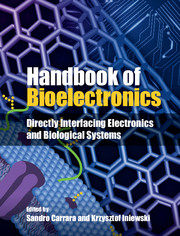Book contents
- Frontmatter
- Contents
- List of Contributors
- 1 What is bioelectronics?
- Part I Electronic components
- 2 Molecular components for electronics
- 3 Nanogaps and biomolecules
- 4 Organic thin-film transistors for biological applications
- 5 Protein-based transistors
- 6 Single-molecule bioelectronics
- 7 Nanoscale biomemory device composed of recombinant protein variants
- Part II Biosensors
- Part III Fuel cells
- Part IV Biomimetic systems
- Part V Bionics
- Part VI Brain interfaces
- Part VII Lab-on-a-chip
- Part VIII Future perspectives
- Index
- References
6 - Single-moleculebioelectronics
from Part I - Electronic components
Published online by Cambridge University Press: 05 September 2015
- Frontmatter
- Contents
- List of Contributors
- 1 What is bioelectronics?
- Part I Electronic components
- 2 Molecular components for electronics
- 3 Nanogaps and biomolecules
- 4 Organic thin-film transistors for biological applications
- 5 Protein-based transistors
- 6 Single-molecule bioelectronics
- 7 Nanoscale biomemory device composed of recombinant protein variants
- Part II Biosensors
- Part III Fuel cells
- Part IV Biomimetic systems
- Part V Bionics
- Part VI Brain interfaces
- Part VII Lab-on-a-chip
- Part VIII Future perspectives
- Index
- References
Summary
Conceptually, extending the premise of bioelectronic interfaces down to thescale of single molecules is a straightforward goal. In practice, thechallenges are purely technological. Single-molecule bioelectronic deviceswould have to involve features much smaller than state-of-the-artsemiconductor electronics, and successful design would have uniquerequirements for sensitivity and stability.
These imposing specifications are balanced by the potential of enormousrewards, because single-molecule bioelectronics would be a breakthroughtechnology for biochemical research and applications. By peering past theensemble behaviors of traditional characterization, single-moleculetechniques aim to directly observe the stochastic fluctuations,instantaneous dynamics, and non-equilibrium behaviors that make up amolecule’s full functionality. Moreover, single-molecule measurementscan uncover the unusual reaction trajectories of a genetically mutatedprotein or a receptor interacting with pharmacological inhibitors. Buildinga better understanding of the precise roles of proteins in complexbiological processes is a grand challenge for biology, biochemistry, andbiophysics in the twenty-first century.
These potential benefits have spurred the development of a variety ofsingle-molecule techniques. Single-molecule fluorescence, specificallyFörster resonance energy transfer (FRET), has become a standard tool forsingle-molecule biochemistry [1]. Meanwhile, single-molecule bioelectronicshas remained elusive, despite the wide-ranging capabilities of modern solidstate electronics.
Information
- Type
- Chapter
- Information
- Handbook of BioelectronicsDirectly Interfacing Electronics and Biological Systems, pp. 66 - 85Publisher: Cambridge University PressPrint publication year: 2015
References
Accessibility standard: Unknown
Why this information is here
This section outlines the accessibility features of this content - including support for screen readers, full keyboard navigation and high-contrast display options. This may not be relevant for you.Accessibility Information
- 1
- Cited by
